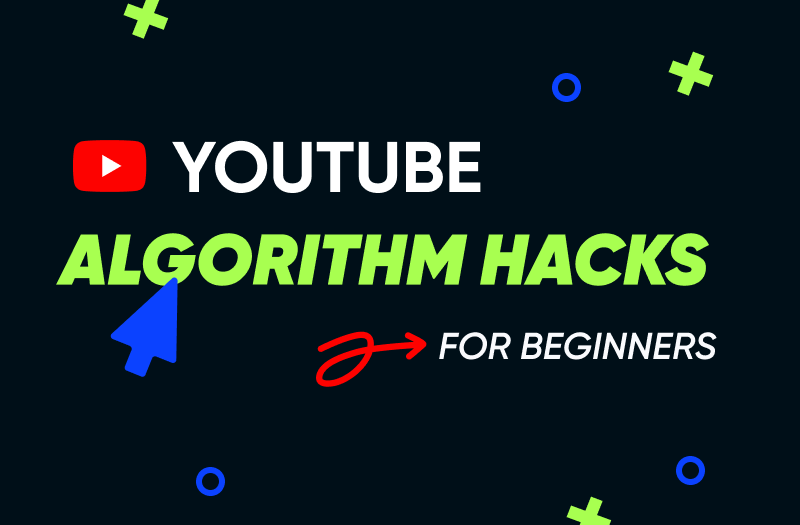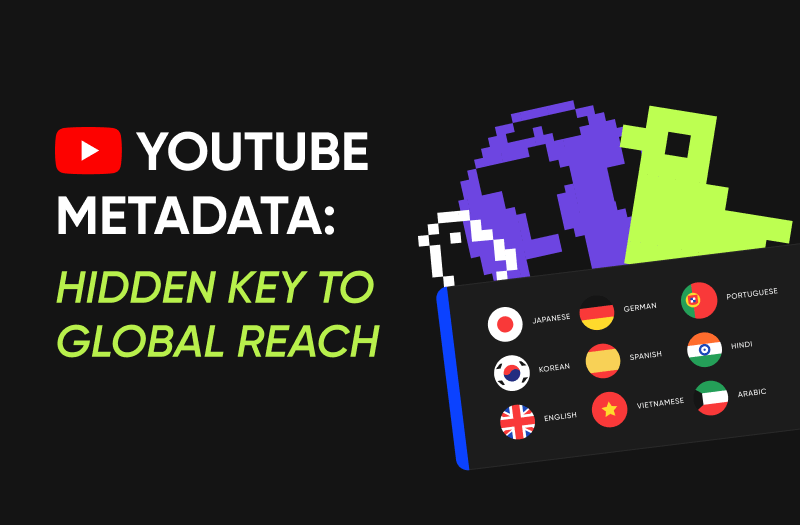
Not Sure Which Languages to Choose?
YouTube metadata might sound like just another technical term, but it's actually super important if you want your videos to get noticed on the platform.
What is YouTube Metadata?
Essentially, YouTube metadata refers to all the information that surrounds your video — stuff like titles, descriptions, and tags. This is the data that tells YouTube's algorithms (and viewers!) what your content is about, who it's for, and why they should watch it.
Metadata also holds potential for reaching global audiences when it's translated into different languages. Our partners have seen their RPMs grow by up to 30% and their watch times increase by up to 35% by adding translated metadata on their channels. AIR Media-Tech can automatically translate your metadata; you can learn how it's done here.
But let's take it step by step and explore how to enhance your metadata to help you improve your rankings, reach global audiences, and boost your revenue.
Video Titles
Starting with YouTube video titles, these are crucial because they're often the first thing a viewer will see and one of the crucial things considered by YouTube algorithms. When it comes to YouTube video titles, clarity and catchiness are key. Here are some tips to help you choose the right title:
- YouTube allows 100 characters for titles, but shorter is generally better. Aim for 60-70 characters to ensure your title is fully visible on all devices without getting cut off.
- Include relevant keywords early in the title. This helps YouTube’s algorithm understand what your video is about and improves its visibility in relevant searches.
- Use professional tools for YouTube creators like VidIQ to spot the right keywords.
Don’t be afraid to experiment with different titles to see what works best. To grab more insights on optimizing your metadata, refer to our article about behind-the-scenes of YouTube algorithm.

Video Descriptions
Moving on to YouTube video descriptions, these give you a little more room to elaborate on the content of your video. You can include key details, backstory, or even a few links. The description helps YouTube understand the context of your video, which can influence when and where it appears on the platform. Here’s how to make the most of it:
- The first 150 characters of your description are crucial. They appear in the search results and before the "Show More" prompt. Make sure these characters are compelling and include key SEO keywords.
- Place important keywords throughout your description to improve SEO, but keep it natural. Overstuffing keywords can appear spammy and may hurt your video's rankings.
- Same with titles, add keywords to your descriptions, especially in the first three lines of the text.
- For maximum results, learn more about SEO optimization of your YouTube channel in our guide here.
By implementing these strategies, you can greatly enhance the effectiveness of your YouTube titles and descriptions, leading to better engagement and increased visibility on the platform.

YouTube Tags
Now, onto YouTube tags. These are specific keywords related to your video that help further define its content for YouTube's search algorithms. Your video tags on YouTube are not visible for viewers. Their purpose is to signal to YouTube's algorithms when, where, and to whom your video should be recommended. When you’re figuring out what tags to use, think about the main topics of your video or the questions it answers. Tags can boost your visibility by aligning your video with viewer searches and related content.
How do you add these tags? When you're uploading a video, you'll find a section to enter these tags under the "tags" field in the video details.
In short, metadata for YouTube isn’t just background information; it's a powerful tool that can make or break your video’s success on the platform. Whether it’s through catchy titles, detailed descriptions, or strategic tags, YouTube video metadata helps ensure that the right viewers find your content at the right time. Now, let's dive into an advanced strategy that can really broaden your global reach: YouTube Metadata Translation.
Enhancing Global Reach with Translated Metadata
Translating your YouTube metadata into multiple languages can significantly extend your video's reach and accessibility. This isn't just about reaching more viewers; it's about strategically targeting viewers in ways that boost your channel's performance:
- Boosting RPMs: By adding languages from countries with high RPMs, you're not just increasing views; you're increasing revenue. It’s all about targeting the right markets to maximize your earnings.
- Boosting Engagement: Consider adding languages from countries where your channel's topic is particularly popular. This approach taps into built-in interest and can significantly enhance viewer engagement and interaction.
- Boosting Views: Adding languages from countries with larger audiences can skyrocket your views. More views mean more exposure and, potentially, more subscribers — it's a virtuous cycle!
With a thoughtful metadata translation strategy, you can enhance all the key metrics on YouTube. Anchor to the Contact Form Try our AI Metadata Translation service and see the impact for yourself.
Testing Your Metadata for Performance
The best metadata strategies come from constant testing. You want to know why? Because what works for one video might not work for another. Consider A/B testing your titles or switching up descriptions and tags to see what drives more clicks and engagement. Use YouTube Analytics to track CTR, watch time, and traffic sources to understand how your metadata impacts performance. Over time, testing reveals what your audience responds to and what the algorithm rewards.
AI-Powered Metadata Creation
AI is changing a lot for YouTube metadata. Instead of spending hours on titles and tags, AI tools can now analyze your video content and generate optimized metadata in seconds. At AIR Media-Tech, our AI Metadata Translation tools help creators automate this process while ensuring the result is relevant, strategic, and multilingual when needed. It’s faster, smarter, and designed to boost visibility and engagement with less manual effort.
What Makes “High-Quality” Metadata?
YouTube’s algorithm favors metadata that’s relevant, descriptive, and aligned with the content of your video. High-quality metadata:
- Uses keywords naturally (no spamming)
- Matches the video’s actual topic & tone
- Is consistent across the title, description, and tags
- Encourages user interaction through links, CTAs, and timestamps.
Avoid misleading or clickbait tactics. They may work short-term, but can damage your channel's trust and long-term performance. Quality metadata builds authority and boosts discoverability the right way.
But Is It Right for Every Channel?
While translating metadata can dramatically improve reach and engagement, it's not a one-size-fits-all solution. Here are a couple of considerations:
- Voice Narration Dependence: If your channel heavily relies on voice narration and the content isn't understandable without it, merely translating the metadata might not be enough. In such cases, you might want to consider full video translation and dubbing to ensure the content is accessible and enjoyable for non-native speakers.
- YouTube Shorts: Channels that primarily produce YouTube Shorts may not see a significant impact from translated metadata alone. YouTube places more emphasis on viewer behavior than metadata for Shorts, so the strategy needs adjusting here. To enhance your YouTube Shorts channel strategy, reach out to us to get expert advice, insights, and tools to boost your growth!
Ideal Candidates for YouTube Metadata Translation
So, who stands to benefit the most from our AI Metadata Translation service? Channels that produce content that's visually rich and easy to understand without much spoken content are perfect candidates. This includes:
- DIY and How-to Channels: Visual, step-by-step content that is easy to follow without needing to understand the language.
- Travel and Nature Channels: Beautiful visuals and universal themes that transcend language barriers.
- Fitness and Workout Channels: Demonstrations that don't rely heavily on verbal instructions.
- Any other channel type that doesn’t heavily rely on voice narration.
If you produce content that is easily understandable even while on mute, our AI Metadata Translation service can easily adapt your videos metadata for different languages and automatically integrate this into your YouTube channel. By targeting the right audiences with translated metadata, you're not just casting a wider net — you're casting a smarter one. Whether you're looking to boost your RPM, engagement, or views, translating your metadata could be the strategic edge you need. Ready to go global? Let’s make it happen together!


